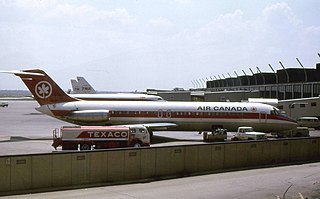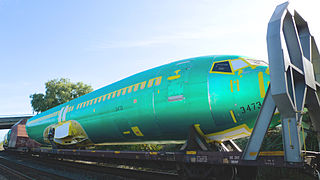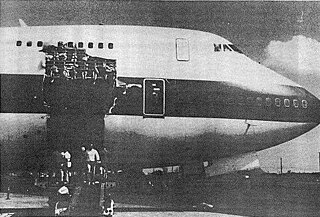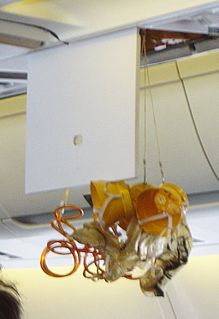Related Research Articles

Flight attendant or is a member of an aircrew employed by airlines aboard commercial flights, primarily to ensure the safety and comfort of passengers. Collectively called the cabin crew, flight attendants are deployed in the cabins of all commercial flights and additionally may also be present on some private or business jets and government or military aircraft.

Air Canada Flight 797 was an international passenger flight operating from Dallas/Fort Worth International Airport to Montréal–Dorval International Airport, with an intermediate stop at Toronto Pearson International Airport. On 2 June 1983, the McDonnell Douglas DC-9-32 operating the service developed an in-flight fire behind the lavatory that spread between the outer skin and the inner decor panels, filling the plane with toxic smoke. The spreading fire also burned through crucial electrical cables that disabled most of the instrumentation in the cockpit, forcing the plane to divert to Cincinnati/Northern Kentucky International Airport. Ninety seconds after the plane landed and the doors were opened, the heat of the fire and fresh oxygen from the open exit doors created flashover conditions, and the plane's interior immediately became engulfed in flames, killing 23 passengers who had yet to evacuate the aircraft.

British Airtours Flight 28M was an international passenger flight which caught fire before takeoff at Manchester Airport, England on 22 August 1985 with the loss of 55 lives. It was en route to Corfu International Airport in Greece.
To assume a brace or crash position is an instruction that can be given to prepare for a crash, such as on an aircraft; the instruction to 'brace for impact!' or 'brace! brace!' is often given if the aircraft must make an emergency landing on land or water. There are many different ways to adopt the brace position, with many countries adopting their own version based on research performed by their own aviation authority or that of other countries. The most common in passenger airliners being the forward-facing seat version, in which the person bracing places their head against or as close as possible to the surface it is likely to strike in the process bending over some degree, placing their feet firmly on the floor, and their hands either on their head or the seat in front.

Aircrew, also called flight crew, are personnel who operate an aircraft while in flight. The composition of a flight's crew depends on the type of aircraft, plus the flight's duration and purpose.

British Airways Flight 5390 was a flight from Birmingham Airport in England for Málaga Airport in Spain that suffered explosive decompression, with no loss of life, shortly after takeoff on 10 June 1990. An improperly installed windscreen panel separated from its frame, causing the plane's captain to be blown partially out of the aircraft. With the captain pinned against the window frame for twenty minutes, the first officer managed to land at Southampton Airport.

Cabin pressurization is a process in which conditioned air is pumped into the cabin of an aircraft or spacecraft, in order to create a safe and comfortable environment for passengers and crew flying at high altitudes. For aircraft, this air is usually bled off from the gas turbine engines at the compressor stage, and for spacecraft, it is carried in high-pressure, often cryogenic tanks. The air is cooled, humidified, and mixed with recirculated air if necessary, before it is distributed to the cabin by one or more environmental control systems. The cabin pressure is regulated by the outflow valve.

United Airlines Flight 811 was a regularly scheduled airline flight from Los Angeles to Sydney, with intermediate stops at Honolulu and Auckland. On February 24, 1989, the Boeing 747–122 serving the flight experienced a cargo door failure in flight shortly after leaving Honolulu. The resulting explosive decompression blew out several rows of seats, resulting in the deaths of nine passengers. The aircraft returned to Honolulu, where it landed safely.

Helios Airways Flight 522 was a scheduled passenger flight from Larnaca, Cyprus to Prague, Czech Republic with a stopover to Athens, Greece, that crashed on 14 August 2005, killing all 121 passengers and crew on board. A loss of cabin pressurization incapacitated the crew, leaving the aircraft flying on autopilot until it ran out of fuel and crashed near Grammatiko, Greece. It was the deadliest aviation accident in Greek history.
An aircraft seat map or seating chart, is a diagram of the seat layout inside a passenger airliner. They are often published by airlines for informational purposes, and are of use to passengers for selection of their seat at booking or check-in.

Trans-Canada Air Lines Flight 304 was operated by a Vickers Viscount 700 aircraft owned by Trans-Canada Air Lines. On July 9, 1956, the No. 4 propeller of the aircraft tore loose from its engine over Flat Rock, Michigan in the United States, during a flight from Chicago, Illinois, to Toronto, Ontario, and Montreal, Quebec; one blade of the propeller sliced through the passenger section of the cabin, killing one passenger and injuring four passengers and one flight attendant. The aircraft diverted to Windsor, Ontario, in Canada, and the pilots carried out an emergency landing. The accident was the first to involve a Vickers Viscount aircraft in scheduled service, and was the first instance of a propeller loss on a turbo-prop aircraft.

An airline seat is a seat on an airliner in which passengers are accommodated for the duration of the journey. Such seats are usually arranged in rows running across the airplane's fuselage. A diagram of such seats in an aircraft is called an aircraft seat map.
In aviation, a jump seat or jumpseat is an auxiliary seat for individuals—other than normal passengers—who are not operating the aircraft. In general, the term 'jump seat' can also refer to a seat in any type of vehicle which can fold up out of the way; vehicles include carriages, automobiles, vans, buses, fire tenders, and taxicabs. The term originated in the United States c. 1860 for a movable carriage seat.

Aircraft emergency oxygen systems or air masks are emergency equipment fitted to pressurized commercial aircraft, intended for use when the cabin pressurisation system has failed and the cabin altitude has climbed above a safe level. It consists of a number of individual yellow oxygen masks stored in compartments near passenger seats and near areas like lavatories and galleys, and an oxygen source, like a centralized gaseous cylinder or decentralized chemical oxygen generator.

An aircraft cabin is the section of an aircraft in which passengers travel. At cruising altitudes of modern commercial aircraft, the surrounding atmosphere is too thin for passengers and crew to breathe without an oxygen mask, so cabins are pressurized at a higher pressure than ambient pressure at altitude.
EmPower is a brand name that refers to three different power outlets available on commercial airlines:

Garuda Indonesia Flight 421 was a scheduled domestic flight operated by Indonesian flag carrier Garuda Indonesia travelling about 625 km (388 mi) from Ampenan to Yogyakarta. On January 16, 2002, the flight encountered severe thunderstorm activity during approach to its destination, suffered flameout in both engines, and ditched in a shallow river, resulting in one fatality and several injuries.

Allegheny Airlines Flight 485 was a regularly scheduled domestic passenger flight between Washington, D.C. and Newport News, Virginia, United States, with three stop-overs, two in Connecticut and a third in Pennsylvania. On June 7, 1971, the Allegheny Airlines Convair CV-580 operating the flight crashed on approach to Tweed New Haven Regional Airport, New Haven County, Connecticut.

Southwest Airlines Flight 812 was a Boeing 737-300 passenger jet that on April 1, 2011, suffered rapid depressurization while cruising at 34,000 ft (10,000 m) near Yuma, Arizona, leading to an emergency landing at Yuma International Airport. Two of the 123 people on board suffered minor injuries. The aircraft was operating Southwest Airlines' domestic scheduled service from Phoenix, Arizona, to Sacramento, California.
References
- ↑ Go-Fly SEP Manual, 2001 Revision
- ↑ "Astronics Website". Astronics Corp. Retrieved 4 December 2019.